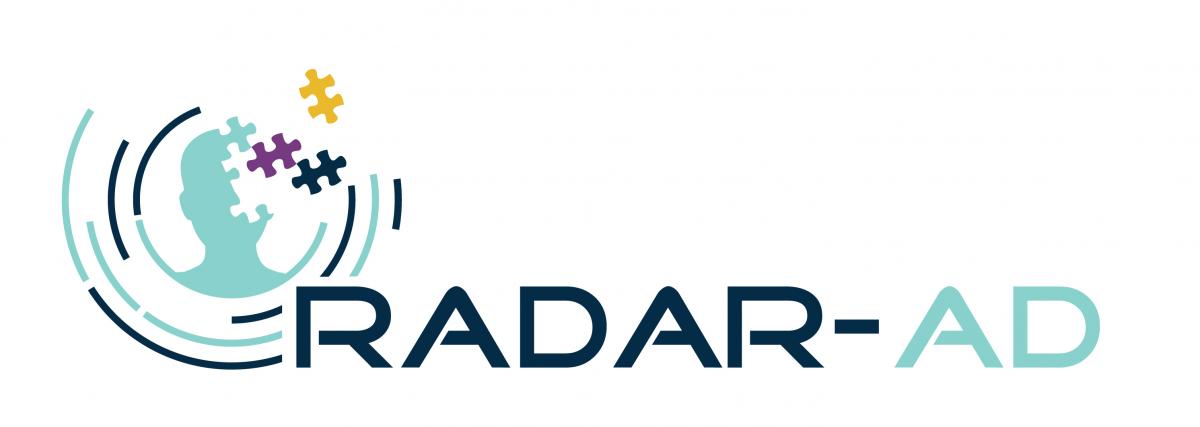Summary
People in the earliest stages of Alzheimer’s disease experience declining cognitive and functional abilities, making it harder for them to remember things and places, carry out simple calculations, use a phone/computer, drive, and adhere to medications.
The goal of the RADAR-AD platform is to develop a digital platform that would draw on smartphone, wearable and home-based digital technologies to track subtle changes in the cognitive and functional abilities of people with Alzheimer’s disease. The project will adapt the existing RADAR-CNS project’s platform for Alzheimer’s disease. Among other things, the team will have to take account of the fact that many people with Alzheimer’s disease are older and so may be less familiar with technology, while their condition may make it more difficult for them to learn to handle technological devices.
People with Alzheimer’s disease will be fundamentally involved in the design and development of the project so that the systems put in place are acceptable and appropriate for them. The platform will be tested in a clinical study with people with different stages of Alzheimer’s disease.
Ultimately, the project results will make it easier to assess how well new dementia treatments work.
Achievements & News
June 2024
The RADAR-AD project put a group of elderly people into a smart home and used sensors to identify whether they...
March 2024
The papers in Frontiers in Neurology demonstrate how public-private collaborative research through IMI and now IHI is making a difference...
IMI’s RADAR-AD project is experimenting with different devices and software to track functional and cognitive decline in Alzheimer’s. ### Researchers from the project told IMI about their achievements so far and their plans for the next steps.
For example, the team is using sensors to measure how well people walk while also counting backwards from 100 to 0. For people with dementia, this is tricky. The team has refined the tests and is now bringing on board more people to expand the dataset they already have so that they can look for causal links between disease and altered walking patterns.
Other tests being assessed by RADAR-AD ask participants to play ‘hide and seek’, or mimic the experience of using an ATM to withdraw cash. Crucially, the team is linking data from some of these tests with data from ADNI, an initiative in which researchers collect data from MRI and PET images, genetics, cognitive tests, CSF and blood biomarkers to make predictions about the disease.
‘Our analysis showed that digital cognitive domains and digital task scores measured via the Altoida app offer a higher accuracy and sensitivity for diagnosing the disease at an early stage than questionnaire-based tests,’ said Meemansa Sood, of the Fraunhofer Institute for Algorithms and Scientific Computing (SCAI).
Find out more
- Read the article in full
Approximately 50 million people worldwide live with dementia, a figure the World Health Organization predicts will triple to 152 million by 2050. By 2030, the global cost of dementia could reach more than USD 2 trillion. To improve the lives of those patients and reduce the associated costs, IMI’s RADAR-AD project is working on using detailed information about the health of each patient to transition from a ‘diagnose and treat’ to a ‘predict and pre-empt’ model of care.###
RADAR-AD is combining mobile and smart home devices with data analytics technologies to provide enhanced care and remote health monitoring for patients with Alzheimer’s disease (AD) at all stages of disease progression.
‘RADAR-AD gives patients the opportunity to be better informed about their own health status and to use this information to self-manage the disease. This will ultimately help personalise care for each patient and allow them to live independently for longer,’ says project coordinator Dag Årsland at King's College London. ‘In parallel, we anticipate that the platform will improve our understanding of Alzheimer’s disease subtypes and progression, supporting the development of new and more effective treatments.’
Participants
Show participants on mapEFPIA companies
- Eli Lilly And Company LTD, Basingstoke, United Kingdom
- Janssen Pharmaceutica Nv, Beerse, Belgium
- Novartis Pharma AG, Basel, Switzerland
- Takeda Pharmaceuticals International AG, Glattpark-Opfikon (Zurich), Switzerland
Universities, research organisations, public bodies, non-profit groups
- Agentschap College Ter Beoordeling Van Geneesmiddelen, Utrecht, Netherlands
- Ethniko Kentro Erevnas Kai Technologikis Anaptyxis, Thermi Thessaloniki, Greece
- Fraunhofer-Gesellschaft zur Förderung der angewandten Forschung e.V., München, Germany
- Karolinska Institutet, Stockholm, Sweden
- King'S College London, London, United Kingdom
- Stichting Amsterdam Umc, Amsterdam, Netherlands
- University of Oxford, Oxford, United Kingdom
Small and medium-sized enterprises (SMEs) and mid-sized companies (<€500 m turnover)
- Altoida AG, Luzern, Switzerland
- Stichting Lygature, Utrecht, Netherlands
- The Hyve BV, Utrecht, Netherlands
Patient organisations
- Alzheimer Europe, Luxembourg, Luxembourg
Associated partners
- Software AG, Darmstadt, Germany
| Participants | |
|---|---|
| Name | EU funding in € |
| Agentschap College Ter Beoordeling Van Geneesmiddelen | 50 000 |
| Alzheimer Europe | 200 500 |
| Ethniko Kentro Erevnas Kai Technologikis Anaptyxis | 349 377 |
| Fraunhofer-Gesellschaft zur Förderung der angewandten Forschung e.V. | 247 250 |
| Karolinska Institutet | 124 096 |
| King'S College London | 882 041 |
| Stichting Amsterdam Umc | 1 273 127 |
| Stichting Lygature | 688 920 |
| The Hyve BV | 467 203 |
| University of Oxford | 717 243 |
| Total Cost | 4 999 757 |
